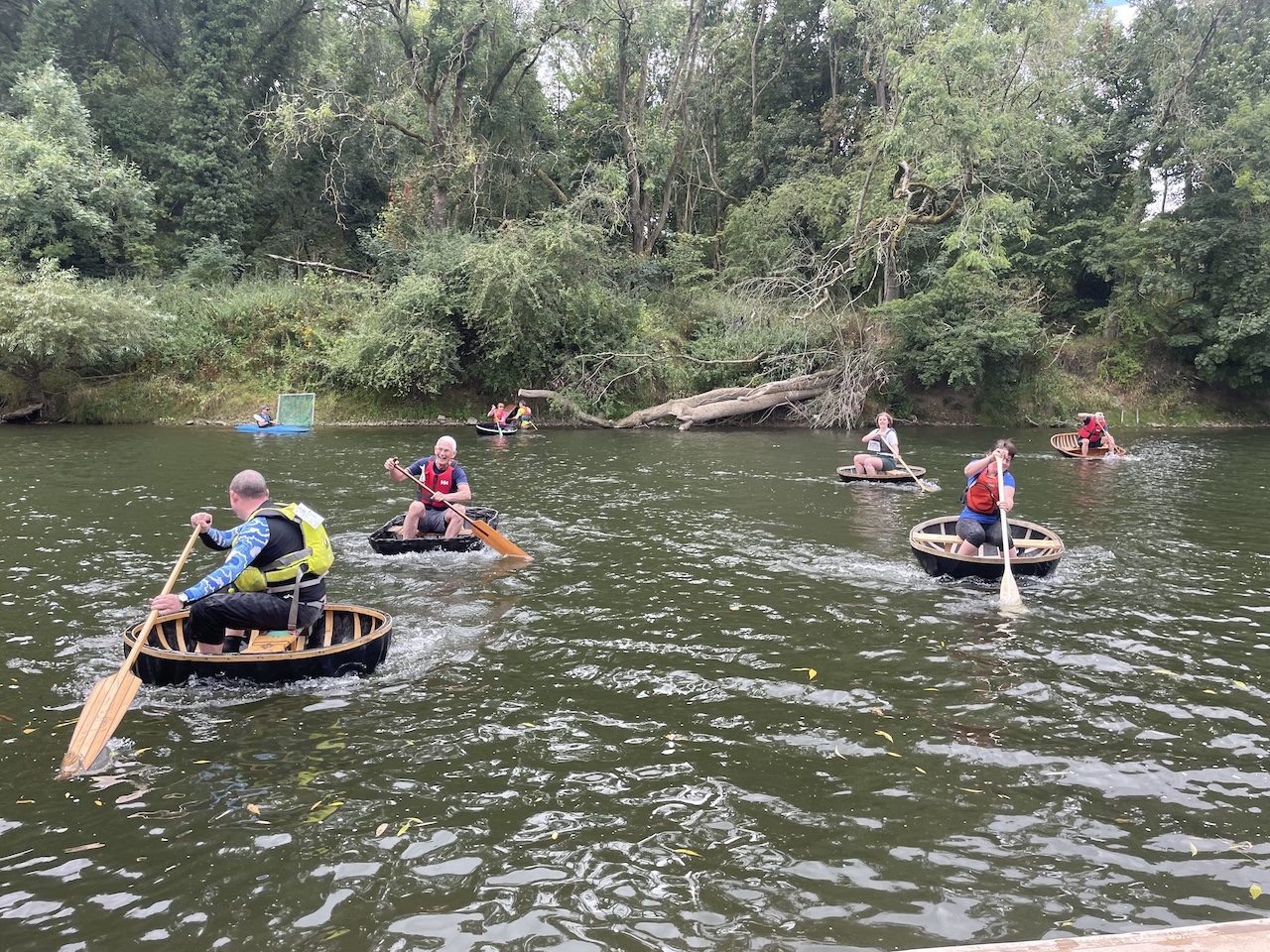Getting into and out of a coracle is the trickiest part of coracling, where you can end up in the pond or river rather than in the boat. This is down to the lack of a keel, resulting in the boat sitting on the water rather than in it. The key to getting in or out of a coracle is to do so as quickly and smoothly as you can. When you are in the boat, it is stable as your weight is distributed across the boat.
If you're coracling with a friend, they can help keep the boat steady whilst you enter or exit. If coracling alone, use the paddle as support, locking it between the bank and your shoulder whilst steadying the boat with your other hand.
After checking for any stones or other objects that may get you stuck or puncture the skin, set the boat in the water with the front against the bank. Step backwards in to the coracle, placing your foot in the centre of the front portion of the boat. Sit down centrally on the seat, before spreading your feet towards the front corners of the boat in order to spread your weight evenly. Then gently push yourself away from the bank.
In shallow water, if the bed is smooth you can set the boat so the front of it will 'lock' as you enter. Once in and stable, you can shuffle yourself backwards onto the water.
Once on the water, try to avoid leaning over the side of the boat. Because of the high centre of gravity and the fact the boat is longer than it is wide, it is very easy to capsize the boat if you lean to the side. Leaning forwards or backwards the boat is much more stable.
Paddling a coracle is a gentle affair - trying to paddle faster will only result in you tiring yourself and won't move you faster. With one hand at the top of the paddle - usually your dominant hand - and the other part way down the paddle handle, use a figure of eight technique over the front of the boat, keeping the paddle blade parallel to the boat. Those familiar with the sculling draw can use this. Use the hand placed down the paddle handle to move the paddle from side to side or to turn it. Keep the paddle blade shallow in the water - placing the blade deeper in the water does not give more power.
To turn the coracle, gently flick the paddle either left or right over the front of the boat to turn in the opposite direction
Once confident in this basic paddling technique, you may wish to try the 'one handed' technique used by coracle netsmen - lock the top of the paddle into your shoulder, usually that of your dominant arm. The hand on the same arm then sits down the paddle handle, operating as above
This video, made by Terry Kenny, may help clarify the paddling technique
Coracles should be stored in a cool, dry place out of direct sunlight. A peg on the garage wall is a good place - the coracle can be hung on the peg, out of the way of day to day traffic, and this will prevent it from being damaged or collecting water. Always empty any water collected in the coracle before storing, as this will cause the skin to rot
Safety on the water
 While using coracles can be enjoyable, the nature of the craft can make it a dangerous activity to participate in.
While using coracles can be enjoyable, the nature of the craft can make it a dangerous activity to participate in.
The Society has published guidelines which we strongly recommend are followed by those who go out on the water. These are available to download below.
Paddle UK (formerly British Canoe Union) also have lots of articles on their website on staying safe while out on the water.
In addition to these safety guidelines, we strongly advise you make yourself aware of the dangers of water quality, in particular Weil's Disease. For more information on Weil's Disease, please see this article on the NHS website
If you capsize a coracle, don't try to re-enter it on the water. If you can flip it over so it is upside down, a cushion of air on the inside of the boat will cause it to float rather than sink, making it easier to rescue and giving you some support. If in distress, try to get the coracle into the upside down position and then use the coracle as a drum, banging on it to raise attention.
It is good practice to wear a buoyancy aid when coracling - even if you are a proficient swimmer. It is also good practice to not coracle alone though if this is unavoidable, ensure someone knows:
- where you are paddling
- where you expect to finish paddling and at approximately what time
Take a phone or radio with you - dry bags are cheap and readily available - so you can contact someone for help or assistance if needed. Remember, calls to emergency services from mobile phones will work on any available network, whether or not your own network has coverage.
Another good idea, if you have a smartphone, is to install the free What3Words app. This app breaks the world down into 3m2 zones identified by three words, which can help anyone - including emergency services - locate you if you get lost or into difficulties.
